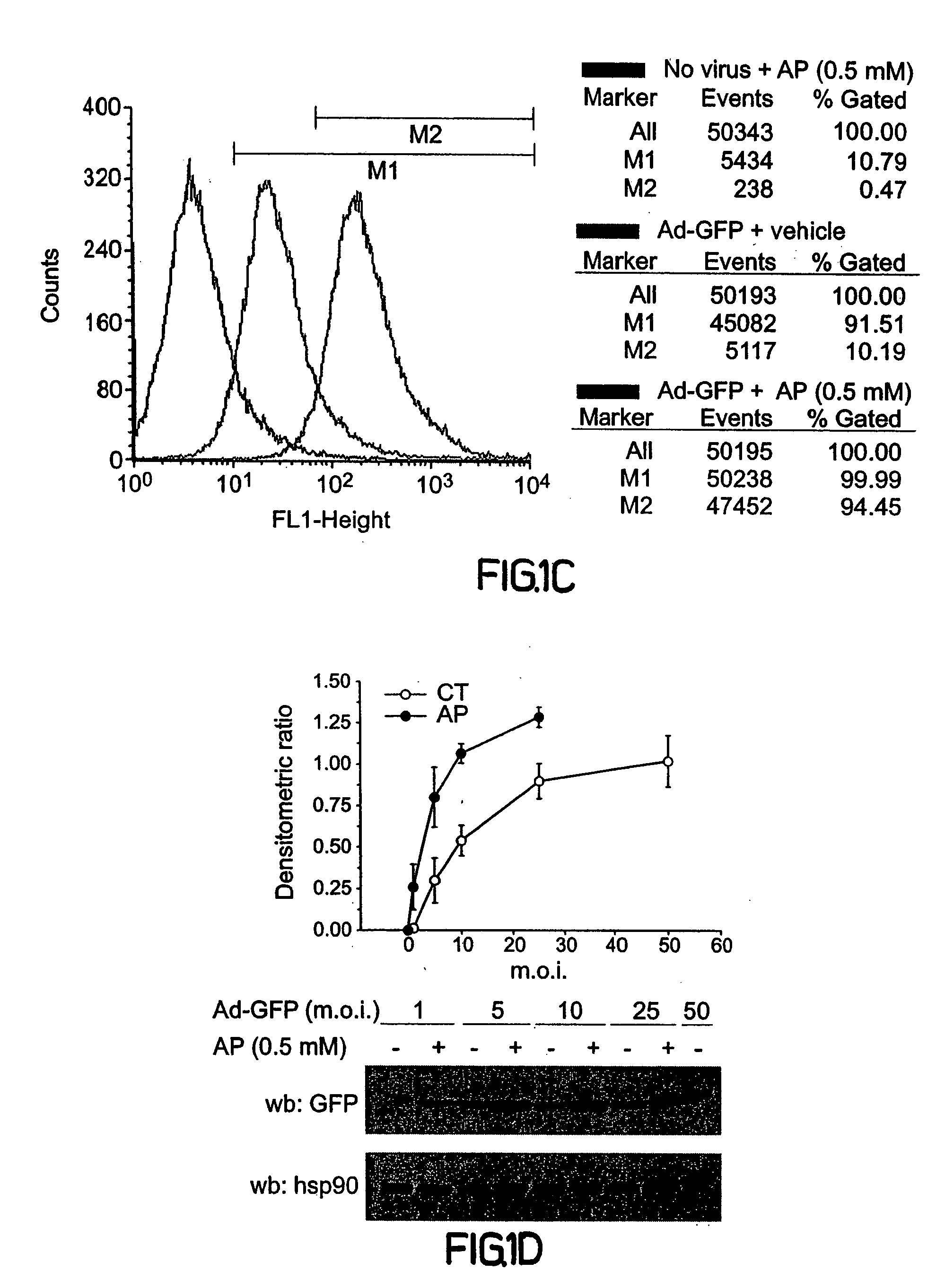Viral uptake into cells and tissues
a technology of viral uptake and cells, applied in the direction of dsdna viruses, application, peptide sources, etc., can solve the problems of limiting the potential study in animals and humans, limiting the efficiency of in vivo cDNA delivery, and no efficient method for this approach has been developed. , to achieve the effect of improving the acetylcholine (ach)-induced relaxation, improving the delivery of functionally relevant genes, and increasing nitric oxide releas
- Summary
- Abstract
- Description
- Claims
- Application Information
AI Technical Summary
Benefits of technology
Problems solved by technology
Method used
Image
Examples
experimental examples
[0155] The invention is now described with reference to the following Examples. These Examples are provided for the purpose of illustration only and the invention should in no way be construed as being limited to these Examples, but rather should be construed to encompass any and all variations which become evident as a result of the teaching provided herein.
[0156] The materials and methods used in the present invention are now described.
[0157] Peptides and Viruses
[0158] Peptides, corresponding to the antennapedia internalization sequence (amino acids 43-58: RQIKIWFQNRRMKWKK; SEQ ID NO:1) or the HIV Tat (amino acids 48-60: GRKKRRQRRRPPQ; SEQ ID NO:2) were synthesized by standard Fmoc chemistry and analyzed by reversed-phase HPLC and mass spectrometry by the W.M. Keck biotechnology resource center at Yale University School of Medicine. Peptides were dissolved in deionized water (stock solution: 25 mM) and sterile filtered before use.
[0159] Replication deficient adenovirus coding ...
example 1
[0183] One possible mechanism to improve cell surface concentrations of viral particles may be through the use of cell permeable peptides. Using cell permeable peptides, an efficient and simple method to increase virally mediated gene delivery, and thus protein expression in cells in vitro and in vivo, has been developed and is described herein.
[0184] To test the effects of pre-complexing adenoviruses with cell permeable peptides prior to cell infection by preincubating the virus with the peptide, COS-7 cells were used as target cells to monitor virally mediated transgene expression with an adenovirus encoding green fluorescent protein (Ad-GFP). Increasing concentrations of a synthetic peptide representing amino acids 43-58 (SEQ ID NO:1) of antennapedia (AP) was used against fixed amounts of Ad-GFP (1 multiplicity of infection; m.o.i., FIG. 1A). AP (0.05 to 5.0 mM) was pre-incubated with Ad-GFP for 30 min at room temperature in serum free media (100 μl; see methods section) prior t...
example 2
[0186] To test whether another known cell permeable peptide has similar effects on adenoviral infection, HIV derived Tat peptide (amino acids 48-60; SEQ ID NO:2) (FIG. 2A; upper panel) was used. The Tat peptide (0.1 and 0.5 mM) was shown to be as efficient as AP at increasing Ad-GFP infection in COS-7 cells (FIG. 2A; lower panel) indicating that this property may be a common feature of polybasic cell permeable peptides. Next, it was determined whether enhanced infection, in the presence of AP, is seen in a primary cell line where adenoviral mediated transgene expression is more difficult. Thus, bovine aortic endothelial cells (BAEC) were exposed to either Ad-GFP alone or the AP / Ad-GFP complex and expression of GFP was monitored by western blotting (FIG. 2B). A marked increase in GFP expression levels was observed in the presence of AP compared to Ad-GFP alone, however the levels of hsp90 remained constant (FIG. 2B). In addition, it was determined whether AP could influence the expre...
PUM
| Property | Measurement | Unit |
|---|---|---|
| w/w | aaaaa | aaaaa |
| temperature | aaaaa | aaaaa |
| rectal temperature | aaaaa | aaaaa |
Abstract
Description
Claims
Application Information
 Login to View More
Login to View More - R&D
- Intellectual Property
- Life Sciences
- Materials
- Tech Scout
- Unparalleled Data Quality
- Higher Quality Content
- 60% Fewer Hallucinations
Browse by: Latest US Patents, China's latest patents, Technical Efficacy Thesaurus, Application Domain, Technology Topic, Popular Technical Reports.
© 2025 PatSnap. All rights reserved.Legal|Privacy policy|Modern Slavery Act Transparency Statement|Sitemap|About US| Contact US: help@patsnap.com



